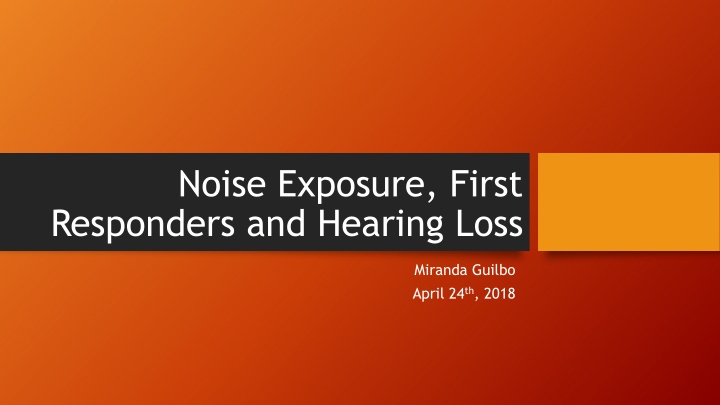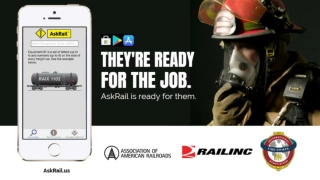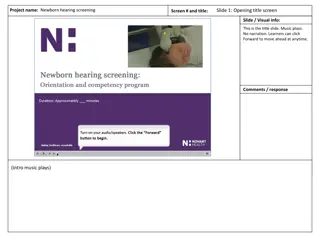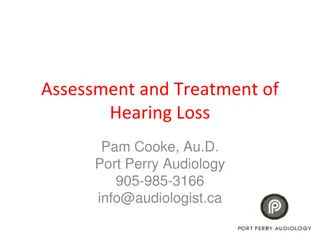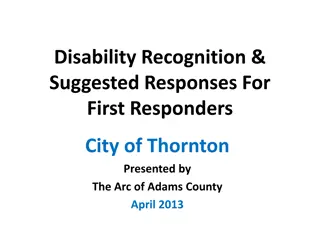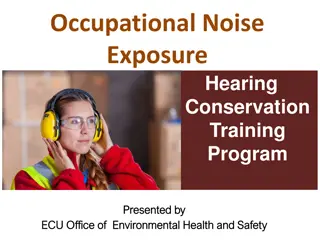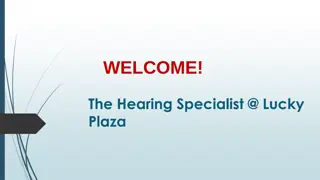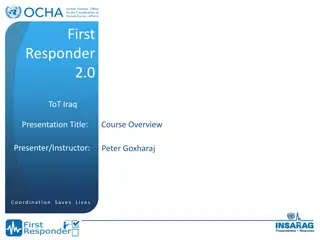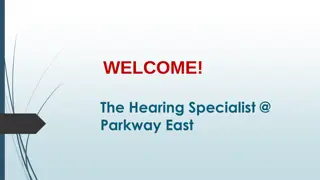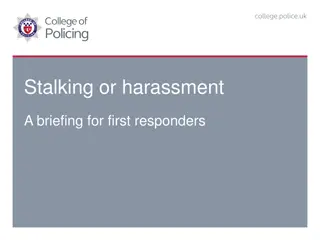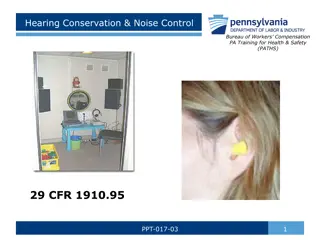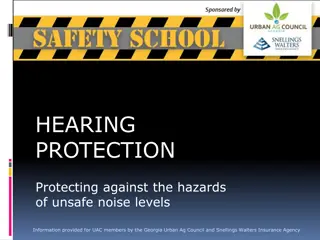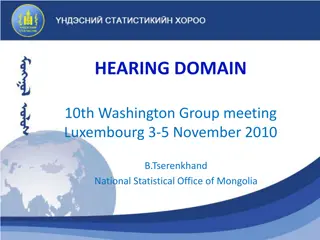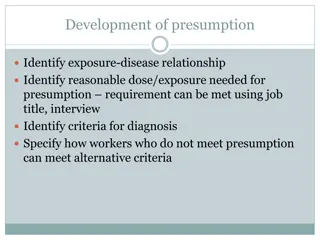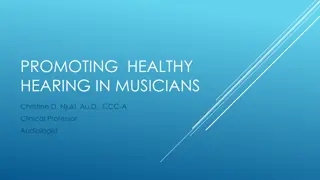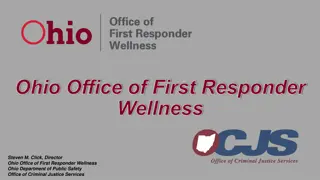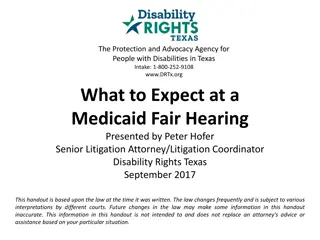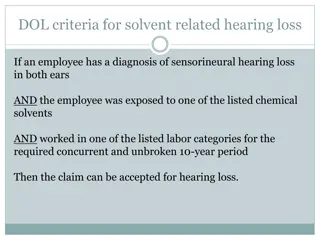Hearing Loss Among First Responders: Risks and Prevalence
This study delves into the association between noise exposure and hearing loss among different first responder occupations, focusing on the use of firearms and protective measures. Initial hypotheses and demographic results of law enforcement officers, firefighters, and other protective service workers are analyzed using CDC NHIS survey data from 2007 and 2014. The prevalence of hearing loss, tinnitus, and potential confounders like diabetes and kidney disease are explored to shed light on the impact of occupational hazards on hearing health in high-risk professions.
Download Presentation

Please find below an Image/Link to download the presentation.
The content on the website is provided AS IS for your information and personal use only. It may not be sold, licensed, or shared on other websites without obtaining consent from the author.If you encounter any issues during the download, it is possible that the publisher has removed the file from their server.
You are allowed to download the files provided on this website for personal or commercial use, subject to the condition that they are used lawfully. All files are the property of their respective owners.
The content on the website is provided AS IS for your information and personal use only. It may not be sold, licensed, or shared on other websites without obtaining consent from the author.
E N D
Presentation Transcript
Noise Exposure, First Responders and Hearing Loss Miranda Guilbo April 24th, 2018
Background Hearing Loss Presbycusis Noise induced: damaged to ear hair cells Other causes Trauma, birth defects, ototoxic chemicals, diabetes, kidney disease Tinnitus may be preliminary or co- symptom https://thehearinginstitute.org/hidden-hearing-loss-effect/
Background (Cont.) BLS estimates 657,690 Police Officers, 327,300 Firefighters in 2016 Due to variance and unpredictability in work, first responders may be at higher risk NIOSH HHE Occupational noise sources: firearms, sirens, machinery, explosions, fires, crowds Firearms produce impulse sound 140-160 dB OSHA PEL: 90 dB 8hr TWA; 140 dB for impulse noise
Specific Aims In different first responder occupations, determine level of association between hearing loss and noise exposures at work noise exposure outside of work firearms use Determine prevalence on hearing protection use and it s effectiveness to protecting from hearing loss
Initial Hypothesis Due to increased use of firearms in and outside of the workplace, law enforcement officers will show a higher prevalence of hearing loss, compared to other first responder occupations and all other occupations.
Methods CDC NHIS 2007 and 2014 Survey data 3 study populations: Law Enforcement Officer, Firefighters, Other Protective Services Reference: All other occupations Main Outcomes: Hearing Loss, Tinnitus Confounders: Diabetes, Kidney Disease, Smoking, Age Other Covariates: Veteran Status, Working Status
Results: Demographics Law Enforcement Workers Other Protective Services All Other Occupations Firefighters Sample % 0.69% LEO 0.15% FF 0.90% OPS 98.26% Mean Age 44.81 47.66 44.01 48.45 Race White (78.48%) White (90.81%) White (68.63%) White (80.67%) Sex Male (76.26%) Male (97.01%) Male (68.17%) Female (54.87%) Veteran 16.39% 20.00% 13.91% 5.78% US Citizen 99.87% 100% 96% 92.55% Annual Income >$75,000 (15.53%) >$75,000 (17.78%) <$15,000 (18.00%) <$15,000 (12.47%)
Results: Continued Law Other Protective Services All Other Occupations Enforcement Workers Firefighters Hearing Less than Good 14.81% 26.33% 16.84% 17.23% Tinnitus 12.60% 17.71% 10.68% 11.00% Exposed to Noise at Work Exposed to Noise Outside of Work 63.09% 43.58% 71.67% 76.47% 42.75% 61.62% 32.46% 26.64% Firearms Use 87.38% 70.38% 50.33% 32.07%
Results: Confounders For hearing worse in one ear , firefighters and other occupations showed equal hearing loss in both ears. Law enforcement showed higher hearing loss in left versus right ear. Self Reported Cause of Hearing Loss Law Enforcement Firefighters 0.68%** 4.03% 3.76%** 5.41% 11.18%* 3.03% 15.39% Hearing Loss Cause Birth Illness or Trauma Impulse Noise Constant Noise Noise of Unknown Source Ageing Other/Unknown Other Protective Services 0.45%** 4.17% 4.65% 4.67% All Other Occupations 1.05% 3.32% 3.64% 3.85% -- 0.86%** 0.72%** 3.78% 2.79% 1.73%* 2.71%* 0.90%** 1.52%* 0.32%* 3.34% 3.87% 2.79%
Results: Hearing Protection Use When asked about hearing protection use during firearms use, 52% of FF with hearing loss used HP less than half the time. LE (86% and 95%) and OPS (74% and 87%) had similar rates of with hearing protection use more than half the time in both hearing loss outcomes. When asked about hearing protection use at work 90% of FF with hearing loss wore HP less than half the time. In LE and OPS, majority reported wearing HP less than half the time, regardless of hearing loss. 82% and 88% for LE; 88% and 93% for OPS. 89% of AOO with hearing loss wore HP more than half the time.
Results: Noise Exposures Outside of Work Exposure to Very Loud Noise Sources Outside of Work in Firefighters Hearing Less than Good Noise Source Total Yes Lawn Mower 43 (77.31%) 18 (38.58%) Farm Machinery 2 (0.02%) Power Tools 38 (62.10%) 16 (44.14%) 22 (55.86%) Household Appliances 23 (36.03%) 14 (66.58%) Vehicles 33 (64.62%) Rock Concerts 17 (29.44%) CD/MP3 Player 7 (38.51%) Other Music 3 (25.69%) Sporting Event 2 (2.22%) Firearms 9 (44.94%) Videogames 1 (15.27%) Other 7 (33.34%) Chi Squared P Value No 25 (61.32%) 0.2308 0.0462 <0.0001 0.4463 0.0811 - 9 (33.42%) 12 (71.15%) 12 (69.87%) 6 (90.41%) 3 (100%) 2 (100%) 6 (74.12%) 1 (100%) 5 (79.25%) 6 (28.85%) 5 (30.13%) 1 (9.59%) - - 3 (25.88%) - 2 (20.75%) - - - -
Results: Multivariable Analysis Association Between Occupation and Hearing Related Issues in Protective Services Hearing Loss Unadjusted Odds Ratio 1.720 (1.069, 2.769) 0.835 (0.602, 1.158) 0.972 (0.761,1.240) Tinnitus 1.742 (1.016, 2.986) 1.166 (0.813, 1.674) 0.967 (0.703, 1.332) P-value Adjusted Odds Ratio 2.055 (1.255, 3.363) 1.090 (0.772, 1.540) 1.166 (0.901, 1.540) P-value Firefighters 0.0254 0.0042 Law Enforcement 0.2790 0.6244 Other Protective Services 0.8175 0.2416 1.822 Firefighters 0.0437 0.0306 (1.058, 3.138) 1.294 (0.896, 1.869) 1.027 (0.743, 1.419) Law Enforcement 0.4035 0.1697 Other Protective Services 0.8391 0.8730
Discussion After adjusting for possible confounders, firefighters were at increased odds for both hearing loss and tinnitus. No significant risk for law enforcement or other protective services Increased odds firefighters possibly due to: Increased noise exposures outside of work Poor use of hearing protection Lack of understanding on hazard of noise exposure
Limitations Cross-Sectional Data Hearing loss is self reported No audiometry measurements Adjusted for age Exposure variables are self reported Noise exposure source, cause of hearing loss Missing data and Small Cell Size Veteran status Sex Citizenship Chemical Exposure
Implications Firefighters should be in workplace hearing conservation programs Education on noise hazards and hearing protection use in and outside of work Encourage use of hearing protection with communication capabilities Engineer control for siren https://www.firecom.com/cutting-out-the-noise/
Works Cited The American Speech-Language-Hearing Association (ASHA). Causes of Hearing Loss in Adults. Retrieved from https://www.asha.org/public/hearing/causes-of- hearing-loss-in-adults/ Bureau of Labor Statistics. (2014) Police Officers Fact Sheet: Injuries, Illnesses, and Fatalities. Retrieved from https://www.bls.gov/iif/oshwc/cfoi/police- officers-2014.htm. EPA report No. 550/9-1981-101, Noise in America. Le T.N., Straatman L.V., Lea J., Westerberg B. Current insights in noise-induced hearing loss: A literature review of the underlying mechanism, pathophysiology, asymmetry, and management options. J. Otolaryngol. Head Neck. Surg. 2017;46:41. doi: 10.1186/s40463-017-0219-x. Lesage F, Jovenin, N, Deschamps, F, Vincent, S. Noise-induced hearing loss in French police officers. Occup Med (Lond). 2009 Oct;59(7):483-6. doi: 10.1093/occmed/kqp091. Lie, A., Skogstad, M., Johannessen, H. A., Tynes, T., Mehlum, I. S., Nordby, K., . . . Tambs, K. (2015). Occupational noise exposure and hearing: a systematic review. International Archives of Occupational and Environmental Health, 89(3), 351-372. doi:10.1007/s00420-015-1083-5 Mantysalo, S and Vuori, J. (1984). Effects of impulse noise and continuous steady state noise on hearing. British Journal of Industrial Medicine. 41: 122-132 Masterson, Elizabeth A., et al. Prevalence of hearing loss in the United States by industry. American Journal of Industrial Medicine, vol. 56, no. 6, May 2012, pp. 670 681., doi:10.1002/ajim.22082. Nageris BI, Raveh E, Zilberberg M, Attias J. Asymmetry in noise-induced hearing loss: relevance of acoustic reflex and left or right handedness. Otol Neurotol. 2007;28:434 437. doi: 10.1097/mao.0b013e3180430191. National Institute on Deafness and Other Communication Disorders. (June 29, 2017). Age Related Hearing Loss. https://www.nidcd.nih.gov/health/age-related- hearing-loss National Institute on Deafness and Other Communication Disorders. (February 7, 2017). Noise-Induced Hearing Loss. https://www.nidcd.nih.gov/health/noise- induced-hearing-loss National Institutes of Health. (2008) Hearing Loss Is Common in People with Diabetes. https://www.nih.gov/news-events/news-releases/hearing-loss-common- people-diabetes Park SK, Elmarsafawy S, Mukherjee B, Spiro A 3rd, Vokonas PS, Nie H., et al. 2010. Cumulative lead exposure and age-related hearing loss: The VA Normative Aging Study. Hear Res 269(1-2):48 55, PMID: 20638461, 10.1016/j.heares.2010.07.004. Sung, Joo Hyun, et al. Relationship of Cigarette Smoking and Hearing Loss in Workers Exposed to Occupational Noise. Annals of Occupational and Environmental Medicine. 2013 Jul 3;25(1):8. DOI: 10.1186/2052-4374-25-8. Tak, SangWoo and Calvert, Geoffrey M. Hearing Difficulty Attributable to Employment by Industry and Occupation: An Analysis of the National Health Interview Survey United States, 1997 to 2003. Journal of Occupational and Environmental Medicine. 2008 Jan; 50(1):46-56. DOI: 10.1097/JOM.0b013e3181579316 Tao L, et al. Effect of cigarette smoking on noise-induced hearing loss in workers exposed to occupational noise in China. Noise & health. 2013;15:67 72. doi: 10.4103/1463-1741.107159. Occupational Health and Safety Administration. Occupational Noise Exposure. Retrieved February 22, 2018, Retrieved from https://www.osha.gov/SLTC/noisehearingconservation/index.html Texas Department of Insurance: Division of Workers Compensation (TDI/DWC). Noise and Hearing Protection FactSheet. Retrieved from http://www.tdi.texas.gov/pubs/videoresource/fsnoise.pdf
